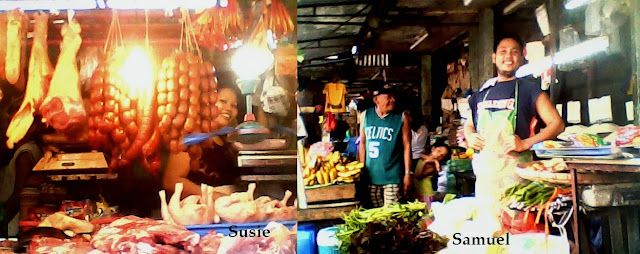The Palengke (Wet Market)
I have talked about my trip to Australia but I haven't taken you to the place where I live yet have I? Well, here's a sneak for you. We had a trip to the wet market a few days ago which we do regularly to buy food but this time, we didn't have a shopping list with us but instead a mobile phone and a digital camera, to capture the essence of what we call here "Palengke."
Now, before I proceed there are two Tagalog words I have to teach you first, terms I'll be using repeatedly in this post.
Baranggay - the smallest administrative division in the Philippines and is the native Filipino term for a village, district or ward. In colloquial usage, the term often refers to an inner city neighbourhood, a suburb or a suburban neighborhood.
Palengke - A palengke is a type of public market common throughout the Philippines. A palengke is usually composed of several dozen stalls arranged in rows under a shared roof. Management is usually by the local governmental units whose jurisdiction encompasses the physical location of the markets.
Not all Baranggays have their own "palengke". I'm blessed I live in one and just a walk away from my house. In the 16 months that my husband has lived here, he's made more friends than I have in the 30 years I've been here. People are fascinated by the 6 foot tall foreigner walking around with a short Filipina on wheels. Almost always someone from the stalls would call out to him "Hey Joe!" to which Russell would reply "Hindi Amerikano, taga- Australia ako." ("Not American, I'm from Australia!"). Everyone seems to think all white men are from America. Not anymore
Here's a short video of us coming to the palengke: Tricycles (motorcyces with side cars), stores, cars parked on the side of the street and people walking about like zombies.
At the "palengke", you will find all sorts of goodies; fruits, vegetables, meat, grocery items even toys, bags and jewelries. The fruits and veggies are daily fresh arrivals from the provinces and seafood (fish, shrimps, clams etc) are fresh from the ports. It's best to buy from the "palengke" early in the day. By eleven in the morning, all you'll have is what the early marketers have left.
Our first stop would be our favorite butcher shop "Ken and Maan's" where we get discounts at times. We've become friends with the owners and staff, "Ken, Maan, Manny and Susie. We're always thankful to Samuel who doesn't mind moving part of his stall that's in the way of my wheelchair going to the butcher shop.
The shop is at the farthest part of the wet market and on our way back, we drop by the newly opened dry market (nearer to my house) where we buy our vegetables, eggs, rice and bananas. Here we've become a weekly customer of Noemi, Danny and Russell's friend he calls "karpentero" (carpenter).
"Palengke" is one of the first words my husband has learned. We go there once a week and we've become familiar faces. When it comes to fresh produce, it's cheaper to buy from there than the mall but the quality is just as good. For us, it's not just the budget but also the convenience, we just walk there but the best part of the "palengke" is the people, friendly and reliable. Even when Russell has misheard the price and given too many coins, they have handed back the surplus. You can't be more honest than that!
John 3:16 - For God so loved the world that He gave His one and only Son, that whoever believes in Him shall not perish but have eternal life.

Comments